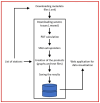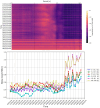SEISMONOISY: A Quasi-Real-Time Seismic Noise Network Monitoring System
- PMID: 38894265
- PMCID: PMC11174729
- DOI: 10.3390/s24113474
SEISMONOISY: A Quasi-Real-Time Seismic Noise Network Monitoring System
Abstract
This paper introduces SEISMONOISY, an application designed for monitoring the spatiotemporal characteristic and variability of the seismic noise of an entire seismic network with a quasi-real-time monitoring approach. Actually, we have applied the developed system to monitor 12 seismic networks distributed throughout the Italian territory. These networks include the Rete Sismica Nazionale (RSN) as well as other regional networks with smaller coverage areas. Our noise monitoring system uses the methods of Spectral Power Density (PSD) and Probability Density Function (PDF) applied to 12 h long seismic traces in a 24 h cycle for each station, enabling the extrapolation of noise characteristics at seismic stations after a Seismic Noise Level Index (SNLI), which takes into account the global seismic noise model, is derived. The SNLI value can be used for different applications, including network performance evaluation, the identification of operational problems, site selection for new installations, and for scientific research applications (e.g., volcano monitoring, identification of active seismic sequences, etc.). Additionally, it aids in studying the main noise sources across different frequency bands and changes in the characteristics of background seismic noise over time.
Keywords: background seismic noise level; real time monitoring; seismic noise; seismic noise trend; seismology.
Conflict of interest statement
The authors declare no conflicts of interest.
Figures
















References
-
- Havskov J., Alguacil G. Instrumentation in Earthquake Seismology. Modern Approaches in Geophysics. Volume 22. Springer; Dordrecht, The Netherlands: 2004. Seismic networks. - DOI
-
- Ringler A.T. Global Seismic Networks: Recording the heartbeat of the Earth. Eos. 2022;103 doi: 10.1029/2022EO225025. - DOI
-
- Sahara D.P., Rahsetyo P.P., Nugraha A.D., Syahbana D.K., Widiyantoro S., Zulfakriza Z., Ardianto A., Baskara A.W., Rosalia S., Martanto M., et al. Use of Local Seismic Network in Analysis of Volcano-Tectonic (VT) Events Preceding the 2017 Agung Volcano Eruption (Bali, Indonesia) Front. Earth Sci. 2021;9:619801. doi: 10.3389/feart.2021.619801. - DOI
-
- Zheng T., Martin M.P., Sung-Joon C., Hani Z. Evidence for crustal low shear-wave speed in western Saudi Arabia from multi-scale fundamental-mode Rayleigh-wave group-velocity tomography. Earth Planet. Sci. Lett. 2018;495:24–37. doi: 10.1016/j.epsl.2018.05.011. - DOI
-
- Quin L., Frank L.V., Christopher W.J., Yehuda B.Z. Spectral Characteristics of Daily to Seasonal Ground Motion at the Piñon Flats Observatory from Coherence of Seismic Data. Bull. Seismol. Soc. Am. 2019;109:1948–1967. doi: 10.1785/0120190070. - DOI
LinkOut - more resources
Full Text Sources

